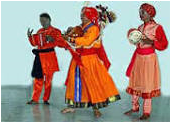The name Andhra is said to have been mentioned in the Aitreya Brahmana of the Rig Veda. It has been ruled by various dynasties like Satavahanas, Ikshvakus, Rashtrakutas, Chalukyas, Cholas and many others of which the Vijayanagara Empire was one of the greatest which left its mark on the culture and heritage of the state. Later the Qutb Shahi dynasty ruled the state in the 16th century followed by the British and later the Nizams.
There are many traditional dances which are popular to this day. They reflect the cultural ethos of the state.
Burra Katha

This dance form has a main story teller with a Burra (musical instrument) who narrates a story which can be a social issue or a mythological theme. He plays music and dances with anklets to it. He is the main performer the katahkudu. His two co-performers play their drums or the dakki that is earthen drums with two heads. They address the main story teller constantly, one acting as a (hasyaka) joker and the other as a (Rajakiya) politician. The comic relief is provided by these two drummers. Burra katha comes under the genre of ballad singing. Even today this is a popular art form and wandering minstrels sing ballads in praise of local heroes. Burra katha has evolved from the Tandana Katha and it is a popular form of entertaining the masses.
Veeranatyam
As the name indicates, it signifies the dance of the brave and is performed by the Veerabhadriya community. It is said to be the dance of destruction when Daksha insulted Shiva’s consort Sati who self immolated herself and this made Shiva furious as portrayed by his vigorous dance known as Veeranatyam. The Veerabhadra dancer holds Khadgam or sword to the synchronisation of Dhandakas or words chanted by other dancers to the vigorous beating of the drums.
Butta Bommalu
In this folk dance, Masks are made as ‘basket puppets’ as the name signifies with dry grass, wood husk and cow dung. They are light and the dancer can move about freely wearing these masks which are of Rama, Hanuman, Krishna and so on depending on the festival during which it is performed.
Tappeta Gullu
This dance is performed by many artists with drums, dancing with devotion invoking the Rain God. Their vigorous tempo and rhythm along with great acrobatics mesmerises the viewers.
Lambadi
The semi-nomadic tribes of the state perform this dance during festive occasions wearing colourful costumes of glass beads and mirrors.
Dhimsa Dance

This tribal dance is performed by all, young and old in the hilly tracts of the state. People of all the villages gather together and sing and dance. This is followed by community feasts.
Kolannalu or Kolatam
This dance is performed with sticks during village festivals with rhythmic steps and movements and is similar to the Garbha or Dandia Ras of Gujarat
